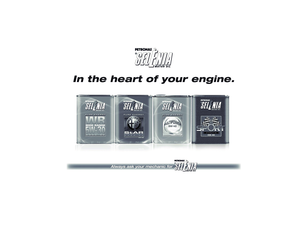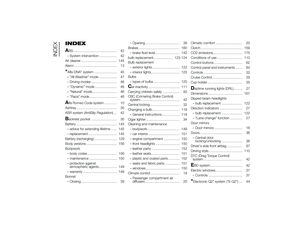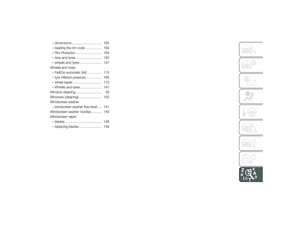Page 113 of 190

DRIVING STYLE
Starting
Do not warm the engine with the car at
a standstill or at idle or high speed:
under these conditions the engine
warms up much more slowly, increasing
consumption and emissions. It is
therefore advisable to move off
immediately, slowly, avoiding high
speeds: in this way the engine will
warm up more quickly.
Unnecessary actions
Avoid accelerating when stopped at
traffic lights or before switching off the
engine. This action is absolutely
pointless and only increases
consumption and pollution.
Gear selection
Using a low gear for faster acceleration
increases consumption.
In the same way, improper use of a high
gear increases consumption,
emissions and engine wear.Max. speed
Fuel consumption increases
considerably with speed. Maintain a
constant speed, avoiding unnecessary
braking and acceleration, which cost
in terms of both fuel consumption and
emissions.
Acceleration
Accelerating violently will greatly affect
consumption and emissions: avoid
frequent and strong accelerations.
CONDITIONS OF USE
Cold starting
Short journeys and frequent cold starts
do not allow the engine to reach
optimum operating temperature.
This results in a significant increase in
consumption levels (from +15 to +30%
on the urban cycle) and emissions.
Traffic and road
conditions
Rather high consumption levels are
linked to situations with heavy traffic, for
instance when travelling in queues
with frequent use of the lower gears or
in cities with many traffic lights.Stops in traffic
During prolonged hold-ups (e.g. level
crossings) the engine should be
switched off.
110
STARTING AND DRIVING
24-9-2013 11:50 Pagina 110
Page 114 of 190

SNOW TYRESUse snow tyres of the same size as the
normal tyres provided with the car:
the dedicated Alfa Romeo Dealership
will be able to advise you on the most
appropriate tyre to use.
Only use these tyres in the event of ice
or snow on the roads.
For the type of tyre to be used, inflation
pressures and the specifications of
snow tyres, follow the instructions given
in the "Wheels" paragraph in the
"Technical specifications" chapter.
90)
The performance of these tyres on
low-grip surfaces are reduced
considerably when the tread depth is
below 4 mm. They should be replaced
in this case.
Due to the specific characteristics of
snow tyres, in normal weather
conditions or on long motorway
journeys, the performance of these
tyres is lower than that of standard
tyres. Their usage should therefore be
restricted in accordance with their
type approval.IMPORTANT When using snow tyres
with a maximum speed index below the
one that can be reached by the car
(increased by 5%), place a notice in the
passenger compartment, plainly in
view, which states the maximum speed
allowed by the snow tyres (as per EC
Directive).
All four tyres should be the same brand
to ensure greater safety when driving
and braking as well as making the
car more responsive. It is inadvisable to
change the rotation direction of tyres.
Refer to the "Raising the car" section in
the "In an emergency" chapter for
further details on how to raise the car
correctly.
WARNING
90) The maximum speed for snow
tyres marked “Q” is 160 km/h,
while it is 190 km/h for “T” tyres
and 210 km/h for "H" tyres. The
highway code speed limits must
however always be complied with.
CAR INACTIVITYIf the car is to be left inactive for longer
than a month, observe the following
precautions:
❒park the car in covered, dry and if
possible well-ventilated premises and
slightly open the windows;
❒ check that the handbrake is not
engaged;
❒ disconnect the negative battery
terminal and check the battery
charge. Repeat this check once
every three months during storage.
For optimum preservation of the
battery charge, it is advisable to use
the charge-holder (for versions/
markets, where provided, or
alternatively, available from
Lineaccessori). For more details on
its operation, refer to the attached
Supplement;
❒ if the battery is not disconnected
from the electrical system, checks its
state of charge every thirty days;
❒ clean and protect the painted parts
using protective wax;
111
24-9-2013 11:50 Pagina 111
Page 115 of 190

❒sprinkle talcum powder on the rubber
blade of the windscreen wiper and lift
it off the glass (for the correct lifting
procedure, refer to the "Windscreen
wiper" paragraph in the
"Maintenance and care" chapter);
❒ cover the car with a cloth or
perforated plastic sheet. Do not use
sheets of non-perforated plastic
as they do not allow moisture on the
car body to evaporate;
❒ inflate tyres to +0.5 bar above the
standard prescribed pressure and
check it periodically;
❒ do not drain the engine cooling
system;
❒ every time the car is left inactive for
two weeks or longer, run the air
conditioning system for about
5 minutes, set to outside air and with
fan set to maximum, with the engine
idling; this operation will ensure
adequate lubrication to minimise the
possibility of damage to the
compressor when the system is put
back into operation; ❒
ensure that the air intake directly in
front of the windscreen is not
obstructed by leaves or other foreign
bodies; any leaves in the air intake
could reduce the air flow and, if they
enter the reservoir, could prevent
water drainage. In winter months,
make sure that the air intake is not
obstructed by ice, mud or snow.
IMPORTANT After turning the ignition
key to STOP, wait at least 1 minute
before disconnecting the electrical
supply to the battery.
112
STARTING AND DRIVING
24-9-2013 11:50 Pagina 112
Page 116 of 190
IN AN EMERGENCY
A punctured tyre or a burnt-out bulb?
At times, a problem may interfere
with our journey.
The pages on emergencies can help
you to deal with critical situations
independently and with calm.
In an emergency we recommend that
you call the freephone number found in
the Warranty Booklet.
You can also use the freephone number
00 800 2532 4200 to find your nearest
dedicated Alfa Romeo Dealership.STARTING THE ENGINE .................114
REPAIRING A WHEEL .....................115
CHANGING A BULB .......................118
REPLACING EXTERIOR BULBS......122
INTERIOR BULB REPLACEMENT ...125
REPLACING FUSES........................126
RECHARGING THE BATTERY ........129
RAISING THE CAR..........................129
TOWING THE CAR .........................130
113
24-9-2013 11:50 Pagina 113
Page 117 of 190

STARTING THE
ENGINEContact the dedicated Alfa Romeo
Dealership immediately if
warning
light stays on constantly on the
instrument panel.
JUMP STARTING
If the battery is flat, start the engine
using an auxiliary battery with the same
capacity or a little higher than the flat
one.
11)
91)
Proceed as follows to start the car:
❒ connect the positive terminals (+ sign
near the terminal) of the two batteries
with a jump lead fig. 79; ❒
with a second lead, connect the
negative terminal(−)oftheauxiliary
battery to an earthing point
on
the engine or the gearbox/
transmission of the car to be started;
❒ start the engine; when the engine has
started, remove the leads, reversing
the order above.
If after a few attempts the engine does
not start, do not persist but contact
the dedicated Alfa Romeo Dealership.
IMPORTANT Do not connect the
negative terminals of the two batteries
directly! If the auxiliary battery is
installed on another car, check that
there is no accidental contact between
metallic parts of the two cars.
BUMP STARTING
Never, under any circumstances, jump
start the engine by pushing, towing
or coasting downhill.
IMPORTANT
11) Never use a fast battery charger to start the engine as this could
damage the electronic systems
and the ignition and engine supply
control units.
WARNING
91) This procedure must beperformed by qualified personnel
as incorrect actions may cause
high-intensity electrical discharge.
Furthermore, battery fluid is
poisonous and corrosive: avoid
contact with skin and eyes. Keep
naked flames and lit cigarettes
away from the battery and do not
cause sparks.
79
A0L0116
114
IN AN EMERGENCY
24-9-2013 11:50 Pagina 114
Page 118 of 190

REPAIRING A WHEELGENERAL
INSTRUCTIONS
The car is equipped with a quick tyre
repair device called the "Fix&Go
automatic" kit.
92) 94)
To use it, follow the instructions below.
93) 95) 96)
12)
2)
"Fix&Go automatic" KIT
It is located in the luggage
compartment.
The kit includes:
❒bottle A fig. 80 containing sealant
and fitted with: filling tube B and
adhesive label C with the wording
“max. 80 km/h” to be placed in
a clearly visible position (e.g. on the
dashboard) after repairing the tyre;
❒ compressor D complete with
pressure gauge and connectors;
❒ an information leaflet fig. 81,
providing instructions for using the kit
correctly. This booklet should be
given to the persons charged with
handling the tyre treated with this kit;
❒ a pair of gloves located in the side
compartment of the compressor;
❒ adaptors for inflating different
elements. IMPORTANT The sealant is suitable for
use at temperatures in the range from
−20°C to +50°C. The sealant has an
expiry date. INFLATION PROCEDURE
Proceed as follows:
97)
❒
engage the handbrake, unscrew the
tyre valve cap, take out filler hose A
fig. 82 and tighten ring nut B on
the tyre valve;
❒ make sure that switch A fig. 83 for
the compressor is in position 0 (off),
start the engine, insert the plug
into the cigar lighter socket on the
central tunnel (see fig. 84) and switch
on the compressor by bringing
switch A fig. 83 to I (on);
❒ inflate the tyre to the pressure
indicated in the “Wheels” paragraph
in the “Technical data” chapter. In
order to obtain a more precise
reading, check the pressure value on
pressure gauge B fig. 83 with the
compressor off;
80
A0L0076
81
A0L0077
82
A0L0078
115
24-9-2013 11:50 Pagina 115
Page 119 of 190

❒if after 5 minutes it is impossible to
reach at least 1.8 bar, disconnect
the compressor from the valve and
power socket, then move the car
forwards approximately 10 metres in
order to distribute the sealant inside
the tyre evenly, then repeat the
inflation operation; ❒
if you still cannot obtain a pressure of
at least 1.8 bar within 5 minutes from
the compressor switching on, do
not drive off and contact a dedicated
Alfa Romeo Dealership;
❒ after driving for about 10 minutes
stop and check the tyre pressure
again; remember to engage the
handbrake;
❒ if a pressure value of at least 1.8 bar
is detected, restore the correct
pressure (with the engine running and
the handbrake engaged), resume
driving and drive with great care to a
dedicated Alfa Romeo Dealership.
98) 99) 100)
CHECKING AND
RESTORING TYRE
PRESSURE
The compressor can also be used to
check and, if necessary, restore the tyre
pressure.
Release quick connector A fig. 85 and
connect it directly to the valve of the
tyre to be inflated. REPLACING THE BOTTLE
Proceed as follows:
❒
release connector A fig. 86 and
disconnect tube B;
❒ turn the bottle to be replaced
anticlockwise and raise it;
❒ insert the new bottle and turn it
clockwise;
❒ insert connector A and tube B in their
housings.
83
A0L0079
84
A0L0080
85
A0L0081
86
A0L0082
116
IN AN EMERGENCY
24-9-2013 11:50 Pagina 116
Page 120 of 190

WARNING
92) Indicate the presence of thestationary car in accordance with
current regulations: hazard
warning lights, warning triangle,
etc. Those on board should get
out of the vehicle and wait for the
wheel to be repaired away from
the threat posed by the traffic.
If parked on a slope or rough
surface, chock the wheels with
wedges or other suitable devices
(for the correct procedure for
parking the car safely, refer to the
"Parking" paragraph in the
"Starting and driving" chapter).
93) Give the booklet to the technicians who will be handling
the tyre that was treated using
the "Fix&Go automatic" kit.
94) A repair is not possible if the wheel rim is damaged (groove
is deformed, causing air to
escape). Do not remove foreign
bodies (screws or nails) from the
tyre. 95) Do not use the compressor for
more than 20 consecutive
minutes. Risk of overheating. The
kit is not suitable for definitive
repairs, so the repaired tyres may
only be used temporarily.
96) The bottle contains ethylene glycol and latex: it may cause
an allergic reaction. It is harmful if
swallowed. Eye irritant. It may
cause sensitisation if inhaled or
on contact. Avoid contact with
eyes, skin and clothes. In the
event of contact, rinse
immediately with plenty of water.
If ingested, do not induce
vomiting. Rinse out your mouth,
drink large quantities of water and
seek immediate medical attention.
Keep out of the reach of children.
The product must not be used
by asthmatics. Do not inhale the
vapours during insertion and
suction. Call a doctor immediately
if allergic reactions are noted.
Store the bottle in its special
compartment, away from sources
of heat. The sealant has an expiry
date. Replace the bottle if the
sealant has expired.
97) Wear the protective gloves provided with the kit. 98) Apply the adhesive label where it
can be easily seen by the driver as
a reminder that the tyre has been
treated with the quick repair kit.
Drive carefully, especially on
corners. Do not exceed 80 km/h.
Avoid sudden acceleration or
braking.
99) If the pressure has fallen below 1.8 bar, do not drive any further:
the Fix&Go automatic quick tyre
repair kit cannot guarantee proper
hold because the tyre is too
damaged. Contact a dedicated
Alfa Romeo Dealership.
100) Always indicate that the tyre was repaired using the quick
tyre repair kit. Give the booklet to
the personnel charged with
handling the tyre treated with the
repair kit.
117
24-9-2013 11:50 Pagina 117
 1
1 2
2 3
3 4
4 5
5 6
6 7
7 8
8 9
9 10
10 11
11 12
12 13
13 14
14 15
15 16
16 17
17 18
18 19
19 20
20 21
21 22
22 23
23 24
24 25
25 26
26 27
27 28
28 29
29 30
30 31
31 32
32 33
33 34
34 35
35 36
36 37
37 38
38 39
39 40
40 41
41 42
42 43
43 44
44 45
45 46
46 47
47 48
48 49
49 50
50 51
51 52
52 53
53 54
54 55
55 56
56 57
57 58
58 59
59 60
60 61
61 62
62 63
63 64
64 65
65 66
66 67
67 68
68 69
69 70
70 71
71 72
72 73
73 74
74 75
75 76
76 77
77 78
78 79
79 80
80 81
81 82
82 83
83 84
84 85
85 86
86 87
87 88
88 89
89 90
90 91
91 92
92 93
93 94
94 95
95 96
96 97
97 98
98 99
99 100
100 101
101 102
102 103
103 104
104 105
105 106
106 107
107 108
108 109
109 110
110 111
111 112
112 113
113 114
114 115
115 116
116 117
117 118
118 119
119 120
120 121
121 122
122 123
123 124
124 125
125 126
126 127
127 128
128 129
129 130
130 131
131 132
132 133
133 134
134 135
135 136
136 137
137 138
138 139
139 140
140 141
141 142
142 143
143 144
144 145
145 146
146 147
147 148
148 149
149 150
150 151
151 152
152 153
153 154
154 155
155 156
156 157
157 158
158 159
159 160
160 161
161 162
162 163
163 164
164 165
165 166
166 167
167 168
168 169
169 170
170 171
171 172
172 173
173 174
174 175
175 176
176 177
177 178
178 179
179 180
180 181
181 182
182 183
183 184
184 185
185 186
186 187
187 188
188 189
189






